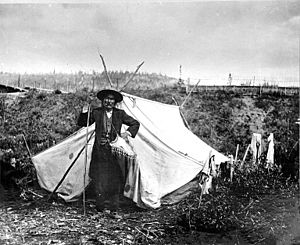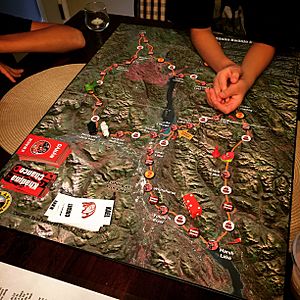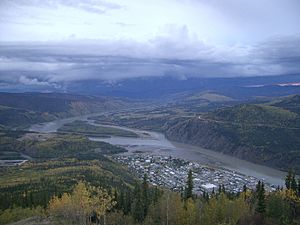Indigenous peoples in Yukon facts for kids
The Indigenous peoples of Yukon are the original groups of people who lived in the area now known as Yukon before Europeans arrived. Most of these groups are part of the larger Dene family. However, there are also Tlingit and Métis nations.
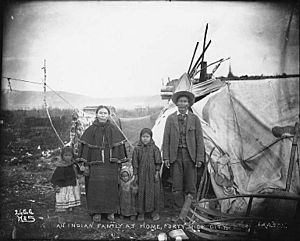
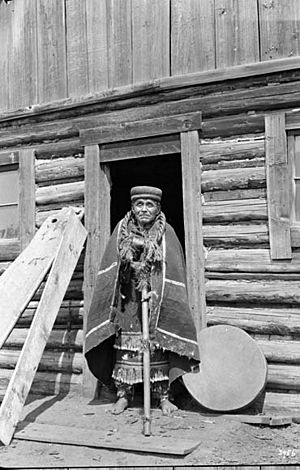
Traditionally, these groups were hunter-gatherers. This means they hunted animals and gathered plants for food. They have always had strong connections to the land, rivers, and seasons of their homelands. Their history and knowledge are passed down through stories and traditions.
When Europeans arrived, many things changed for the Indigenous peoples of Yukon. They lost some of their land, and new ways of governing and educating were introduced. Despite these changes, Indigenous people in Yukon continue to connect with the land through activities like fishing and trapping. Today, they work hard to keep their languages, cultures, and spiritual beliefs alive. They also fight for their indigenous rights.
Contents
How Many People?
It's hard to know exactly how many Indigenous people lived in Yukon before Europeans arrived. It was probably between 7,000 and 9,000 people, or even more, at the start of the 1800s. By 1830, there were about 4,700 Indigenous people living in Yukon.
Different Nations
Yukon is home to several main Indigenous nations:
- The Gwichʼin
- The Hän
- The Kaska Dena
- The Tagish
- The Northern Tutchone
- The Southern Tutchone
- The Tlingit (Teslin)
There are also Métis people and Inuvialuit who have ties to certain parts of Yukon.
The Gwichʼin people live in the areas around the Peel River and the Porcupine River. Their relatives, the Hän, live along the middle part of the Yukon River, near the border with Alaska.
The Northern Tutchone live in central Yukon, near the Pelly River and Stewart River. In the southeast, the Kaska Dena live near the Liard River. In the south, the Tagish people live near lakes in the upper part of the Yukon River. They are related to the Kaska Dena.
The Southern Tutchone live in the southwest. The White River First Nation, who speak an Upper Tanana language, live near the White River.
In the south, along the Teslin River, live the continental Tlingit (Teslin). Their language is part of the Na-Dene language family, which also includes the Athabaskan languages.
Languages Spoken
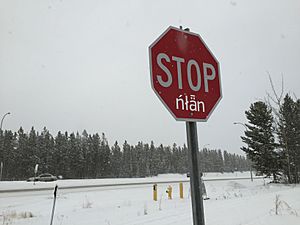
Before Europeans came, people in Yukon spoke different dialects of Athabaskan languages. These languages are still spoken today. Athabaskan languages are part of the larger Na-Dene language family.
A writing system called the Cree Syllabary, first created by a missionary named James Evans, was changed to be used in Yukon. Missionaries also wrote dictionaries and religious books in Indigenous languages, often with help from local translators.
Traditional Ways of Life
The Indigenous peoples of Yukon have a rich oral tradition that is deeply connected to the land. They were, and many still are, skilled hunters and gatherers. They knew how to follow the changing seasons to find food. Fishing and trapping in the valleys are still important activities.
We learn about their traditional ways of life – like how they understood animal behavior, used the land, found food, made clothing, and practiced their spirituality – from their oral histories. Scientists like archaeologists and anthropologists also study these traditions.
European Contact
Europeans, mainly fur traders from the Hudson's Bay Company, started to arrive in Yukon around the 1840s.
Throughout the 1800s, Indigenous people, like the Hän, trapped furs to trade for items made by Europeans.
A very important event was the Klondike Gold Rush in 1896. Many Europeans came to Yukon looking for gold. This brought new diseases, missionaries, and European goods. But it also gave Indigenous peoples new roles. They became guides, packers, and suppliers for the gold prospectors.
By 1898, so many Europeans had arrived that the Yukon territory was formally created.
Land Claims
In the late 1960s, Indigenous people in Yukon started working to get their land rights recognized. The Yukon Indian Advancement Association was formed, and then in 1970, the Yukon Native Brotherhood began a movement for land claims.
In 1973, a petition called Together Today for Our Children Tomorrow was given to the prime minister, Pierre Trudeau, by Elijah Smith. This was a big step. In 1990, the Yukon Final Umbrella Agreement was completed.
Yukon Today
According to the 2016 Canadian census, there were 8,195 Indigenous people in Yukon. Most of them (6,685) were First Nations, 1,015 were Métis, and 230 were Inuit.
In 2012, a study found that only about twelve percent of young Indigenous people could speak their nation's language fluently. There are fourteen First Nations representing eight language groups in Yukon. Since 1991, there has been a program called Voices of the Talking Circle to help preserve these languages. It teaches that the people themselves are the best guardians of their languages, and it's important to have many fluent speakers.
First Nations of Yukon
Here is a list of the fourteen First Nations in Yukon:
- Carcross/Tagish First Nation
- Champagne and Aishihik First Nations
- First Nation of Na-Cho Nyäk Dun
- Kluane First Nation
- Kwanlin Dün First Nation
- Liard First Nation
- Little Salmon/Carmacks First Nation
- Ross River Dena Council
- Selkirk First Nation
- Ta’an Kwäch’än Council
- Tr’ondëk Hwëch’in
- Teslin Tlingit Council
- Vuntut Gwitchin First Nation
- White River First Nation
Most of these First Nations have signed agreements and now govern themselves. The Liard River First Nation, Ross River Dena Council, and White River First Nation are still working towards this.
Other groups with a presence in Yukon include:
- Gwich'in Tribal Council
- Tetlit Gwich’in Council
- Inuvialuit (an Inuit group whose land claims reach into Yukon)
- Acho Dene Koe First Nation
- Kaska Dena Council
- Taku River Tlingit First Nation
- Tahltan Central Council
Languages Spoken by First Nations
The Yukon Government lists these Indigenous languages as being spoken in the territory:
- Gwichʼin language
- Hän language
- Kaska language
- Northern Tutchone language
- Southern Tutchone language
- Tagish language
- Upper Tanana language
- Tlingit language
Unlike the Northwest Territories and Nunavut, no Indigenous languages in Yukon have official status.
First Nations Communities
First Nations people live all across Yukon. Some places that are mainly First Nations communities include:
- Aishihik
- Beaver Creek
- Burwash Landing
- Carcross
- Shäwshe (Dalton Post)
- Fort Selkirk
- Haines Junction
- Mayo
- Old Crow
- Pelly Crossing
- Ross River
- Teslin
- Upper Liard
- Watson Lake
Reserves and Settlements
There are 12 Indian reserves in Yukon. These are lands set aside for First Nations. There are also several places listed as Indian settlements.
Important Historic Sites and Parks
Many historic First Nations sites are found in Yukon, such as Fort Reliance, Forty Mile, Klukshu, Little Salmon, Moosehide, and Takhini Hot Springs.
Kluane National Park and Reserve is located on the lands of the Champagne and Aishihik First Nations and the Kluane First Nation. These nations help manage the park with Parks Canada.
Vuntut National Park was created in 1995 as part of an agreement with the Vuntut Gwitchin First Nation. It is in northern Yukon, next to Ivvavik National Park and the Arctic National Wildlife Refuge in Alaska. The park also includes part of the Old Crow Flats.
Tr'ochëk is a historic fishing site for the Hän people. Chief Isaac of the Trʼondëk Hwëchʼin First Nation had a camp here during the Klondike Gold Rush. It is where the Klondike and Yukon Rivers meet.
Other territorial parks that show First Nations heritage include:
- Agay Mene Territorial Park (proposed)
- Asi Keyi Territorial Park (proposed)
- Ch’ihilii Chìk Habitat Protection Area
- Ddhaw Ghro Habitat Protection Area
- Devil's Elbow and Big Island Habitat Protection Areas
- Dàadzàii Vàn Territorial Park (proposed)
- Kusawa Territorial Park
- Łútsäw Wetland Habitat Protection Area
- Mandanna Lake
- Ni'iinlii'njik (Fishing Branch) Territorial Park
- Nuna K’óhonete Yédäk Tah’é (Horseshoe Slough) Habitat Protection Area
- Pickhandle Lakes Habitat Protection Area
- Ta'tla Mun Special Management Area
- Tagish River Habitat Protection Area
- Tombstone Territorial Park
- Tsâwnjik Chu (Nordenskiold) Habitat Protection Area
- Van Tat K’atr’anahtii (Old Crow Flats) Special Management Area
The Inuvialuit
Even though the Inuvialuit don't live in Yukon anymore, they used to. Inuit people and their ancestors lived on Herschel Island and along the coast of the Arctic Ocean. In 1984, they signed an agreement with the Government of Canada, which led to the creation of two parks.
Herschel Island, in the Beaufort Sea, was first lived in by the Thule people, who were ancestors of the Inuvialuit. It is now part of the Inuvialuit Settlement Region and home to Qikiqtaruk Territorial Park.
Ivvavik National Park is also important to First Nations. It was created as part of the Inuvialuit Final Agreement. The park was established because of concerns about oil exploration in the Beaufort Sea and a proposed pipeline.


